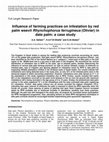Papers by Hamadttu Elshafie
Annual review of entomology, Jan 25, 2024
Palm weevils, Rhynchophorus spp., are destructive pests of native, ornamental, and agricultural p... more Palm weevils, Rhynchophorus spp., are destructive pests of native, ornamental, and agricultural palm species. Of the 10 recognized species, two of the most injurious species, Rhynchophorus ferrugineus and Rhynchophorus palmarum, both of which have spread beyond their native range, are the best studied. Due to its greater global spread and damage to edible date industries in the Middle East, R. ferrugineus has received more research interest. Integrated pest management programs utilize traps baited with aggregation 455

Journal of Economic Entomology, 2015
Adult Rhynchophorus ferrugineus (Olivier) captured in pheromone-baited traps in commercial date p... more Adult Rhynchophorus ferrugineus (Olivier) captured in pheromone-baited traps in commercial date palm orchards in the Al Ahsaa Directorate, Kingdom of Saudi Arabia, were used in computerized flight mill studies to determine the flight characteristics of this highly invasive and destructive palm pest. Flight mill studies were run at three different time periods, winter (December), spring (March), and summer (May). Of the 192 weevils tethered to flight mills $30% failed to fly > 1 km. Of those weevils flying > 1 km (n ¼ 139), 55% flew > 10 km, and of these flyers 5% flew > 50 km in 24 h. Flying weevils exhibited an average weight loss of 20-30% and nonflying control weevils lost $9-13% body weight in 24 h. Male and female weevils flying in summer (average laboratory temperature was $27 C) flew the longest average distances ($25-35 km), exhibited highest weight reductions ($30%), and greatest mortality rates ($80%). Consequently, time of year not weevil sex or color morph had a consistent and significant effect on flight activity, weight loss, and survivorship rates. Flight activity was predominantly diurnal commencing around 5:00 a.m. and peaking between 9-11:00 a.m. before tapering off. The distribution of flight distances combined across season and sex was mesokurtic (i.e., normally distributed).
cultural practices in the control of the green date palm pit scale insect (Asterolecanium phoenic... more cultural practices in the control of the green date palm pit scale insect (Asterolecanium phoenicis Rao.) (Palmapsis phoenicis) (Homoptera: Asterolecaniidae) in

Persian Gulf Crop Protection, 2013
Experiments were undertaken in Elgaba scheme for two seasons (1999/2000 and 2000/2001) to evaluat... more Experiments were undertaken in Elgaba scheme for two seasons (1999/2000 and 2000/2001) to evaluate the efficacy of imidacloprid (as Confidor 200SL) as part of a technical cultural practices package (earthing, pruning and regular irrigation) in the control of the date palm green pit scale insect Asterolecanium phoenicis (Rao). Four doses of Confidor 200SL (15, 20, 25 and 35 ml/palm) were compared with standard insecticide carbofuran (Furadan 5G (60g/palm) and untreated control. A Completely Randomized Design with six replicates (one palm = replicate) was used. The insects (all developing stages) were counted per cm 2 per leaflet. Eight leaflets, from each palm, were inspected biweekly. Date yield and quality were determined at harvest. Residue analysis was carried out twice on dates, soil and plants intercropped with date palms. Results indicated that percentage mortality of both adults and immature stages were significantly higher in the insecticides treatments than in untreated con...

Galleria mellonella (L.) (Pyralidae) und Spodoptera exigua (hübner) (Noctuidae): Wirkungsuntersch... more Galleria mellonella (L.) (Pyralidae) und Spodoptera exigua (hübner) (Noctuidae): Wirkungsunterschiede zwischen XenTari® (Bacillus thuringiensis aizawai), NeemAzal T/S® und ihren Kombinationen Im Labor wurden die Larven mit trockenem Futter versorgt, das vorher für 20 Sek. in die Testlösung getaucht war. Die Testlösungen, auch in der Kontrolle, wurden mit dem anionischen Detergens Triton X 100 versetzt (10%, davon 0.1 ml). XenTari wurde mit 0.5, 1 und 2 mg/l getestet, NeemAzal mit 2, 4 und 8 mg/l. Bei G. mellonella war die höchste korrigierte Mortalität bei XenTari nach 4 Wochen 77%, bei NeemAzal T/S 100%. So wird letzteres empfohlen. Bei Spodoptera exigua im zweiten Larvenstadium bewirkte XenTari nach 3 Wochen eine maximale Wirkung von 95.6%, während NeemAzal T/S bereits nach 7 Tagen 100% erreichte. Im vierten Larvenstadium erreichte NeemAzal TS eine Mortalität von 46%. Wurden aber beide Präparate bei halber Dosis nacheinander appliziert, war die Wirkung nach 5 Tagen 73% (XenTari zu...

The Canadian Entomologist, 2015
This study investigated thermal aspect potentials of date palm (Phoenix dactylifera(Linnaeus) (Ar... more This study investigated thermal aspect potentials of date palm (Phoenix dactylifera(Linnaeus) (Arecaceae)) infested by red palm weevil (Rhynchophorus ferrugineus(Olivier) (Coleoptera: Curculionidae)) in early detection. Palms were forced infested,i.e., fertile females and males were introduced inside the palms to initiate infestation. Effects of three infestation intensities on date palm were examined throughout a 24-day period. Temperature gradients inside infested and healthy palms of the commercial cultivar (Khalas) were determined using data loggers. Adult weevils and loggers were introduced inside holes drilled in palm trunks for measuring temperatures at 15-minute intervals during 24 consecutive days. These 24 days after infestation is the larval stage where most of the damage occurs and the infested palms can still be rescued through remedial control measures. A repeated measures analysis showed that the temperature of infested palms during the two seasons of the study were 3...
Outlooks on Pest Management, 2015
ABSTRACT

Red Palm Weevil (Rhynchophorus ferrugineus) is one of the world’s most destructive palm pests yet... more Red Palm Weevil (Rhynchophorus ferrugineus) is one of the world’s most destructive palm pests yet very little is known about its natural dispersal and flight activity. This pest has had a prolific invasion history due to worldwide human movement of palms but it also has the ability to invade new areas on its own. Anecdotal literature reports indicate that RPW may be able to fly 3-5km but no robust testing has been performed to confirm the validity of this suggested flight distance. While RPW research has been ongoing for many years utilizing this assumption, the lack reliable data to confirm flight dispersal capabilities prevents the true effective development of quarantine protocols or establishment of applicable farming practices within an infected region. In an attempt to better understand RPW dispersal potential, we conducted 2 studies in Al Ahsaa, Saudi Arabia over 3 seasons in 2011-2012 (winter, spring and summer). The studies were: 1) Capture-Mark-Release- Recapture studies i...

Greenhouse experiments were conducted at Khartoum (Sudan) with the aphid predator Hippodamia vari... more Greenhouse experiments were conducted at Khartoum (Sudan) with the aphid predator Hippodamia variegata, two botanical and one synthetic insecticides: neem seed water extract (25 g fresh seed powder per l of water), NeemAzal T/S ® (1 % azadirachtin A) and fenvalerate (Sumicidin ® 20 % EC). An equivalent of 400 l/ha was applied with a plastic hand sprayer, containing 0.2 l Sumicidin (40 g/ha fenvalerate), 1.6 l NeemAzal (16 g/ha azadirachtin A) or 10 kg of neem seed powder (ca. 30 g/ha azadirachtin A was applied as neem seed water extract). The beetles were fed on Aphis gossypii reared on cucumber leaves. Four different stages of the predator were sprayed topically with the test preparations. In addition, beetles were fed on A. gossypii either topically sprayed or collected from cucumber plants, which soil was treated four days earlier. The preparations varied in their effects on the different stages of the predator. Neem weed water extract was less harmful to the predator than NeemAzal T/S. In topical treatments with NeemAzal T/S the corrected mortality (%) was: eggs 37.7, larvae 40.0, pupae 38.2, and adults 16.7; with neem seed water extract: eggs 15.1, larvae 26.7, pupae 29.4, and adults 10.0; with fenvalerate: eggs 86.8, larvae 100, pupae 73.5, and adults 100. Feeding L2 larvae and adults on contaminated aphids resulted in the following corrected mortalities (%): Sumicidin 100, NeemAzal ca. 40 and neem seed water extract 20/17 (larvae/adults). Feeding on aphids treated via the soil with neem seed water extract resulted at maximum in 26.4/16.7 % corrected mortality (larvae/adults), while no effects on the longevity of adults could be observed. So, in contrast to Sumicidin, neem preparations (being effective against pests) proved to be harmless for the beneficial beetle. The results are discussed concerning their importance for plant protection.
Journal of Plant Diseases and Protection

Field strain adults of the red palm weevil (RPW), Rhynchophorus ferrugineus, were collected from ... more Field strain adults of the red palm weevil (RPW), Rhynchophorus ferrugineus, were collected from Al-Hassa, Eastern Province, Saudi Arabia. Four different insecticides; three of which synthetic insecticides viz. beta-cyfluthrin, deltamethrin, and acephate, and one bio-insecticde, matrine were evaluated against egg, larva and adult (male & female) stages of R. ferrugineus (Olivier) under laboratory conditions. These stages were exposed to residual film on transparent plastic cups of each insecticide using Potter precision laboratory spray tower device. Percent mortality of males and females was recorded after exposure time of 0.5, 2.0 and 24 hrs. After exposing the males and females for 2 hrs to 100 and 300 ppm, deltamethrin caused 33.3% and 86.7% morality against males with LC50 136.5 ppm and 20% and 93.3% against females with LC50 value of 164.23 ppm. Whereas, beta-cyfluthrin caused 46.7% and 86.7% mortality against males with LC50 value of 135.74 ppm and 46.7% and 93.3% against fem...
International Journal of Agriculture and Biology

The Kingdom of Saudi Arabia is among the leading date producing countries accounting for nearly 1... more The Kingdom of Saudi Arabia is among the leading date producing countries accounting for nearly 15% of the global date production. Red palm weevil (RPW), Rhynchophorus ferrugineus (Olivier) has been identified by the FAO of the United Nations as a 'category-1' insect pest of date palm in the Gulf region of the Middle-East and is a key pest of date palm in the Kingdom. We ascertained the vertical distribution of infestation due to RPW on the palm, age of infested palms, besides determining the influence of various date palm farming practices viz. type of cultivar infested, number of offshoots on infested palm, type of irrigation and spacing adopted on infestation levels by RPW in date palm by inspecting 393date plantations (234ha) in the Al-Hassa oasis of Saudi Arabia. Our results indicate that infestations were being detected early in the study area, as only 22% of the infested palms were in the advanced staged of attack warranting eradication. However, infestations were wid...

The date palm, Phoenix dactylifera L. (Arecales: Arecaceae) is subject to damage by numerous arth... more The date palm, Phoenix dactylifera L. (Arecales: Arecaceae) is subject to damage by numerous arthropod pests. This review lists 112 species of mite and insect pests associated with date palm distributed among 10 orders and 42 different families. Of these species, few are identified as major or potential pests of date palm tree. The listed species are classified according to their preferred part on the tree into: 34 species on the foliages, 30 species on palm bases, stem and roots, 26 species on inflorescences, bunch stalks, green and ripening fruits, and 22 species attacking date during harvest and storage. In addition to harmful insect and mite pests, more than 45 predators and parasitoids in 7 orders and 15 families are identified. Ten species are considered as major pests viz., the red palm weevil (Rhynchophorous ferrugineus), Old world date mite (Oligonychus afrasiaticus), lesser date moth (Batrachedra amydraula), Dubas date bug (Ommatissus binotatus), green pit scale (Palmapsis...

The main objective of this investigation was to assess the toxicity and growth regulating potenti... more The main objective of this investigation was to assess the toxicity and growth regulating potential of Jatropha (Jatropha curcas L.), neem (Azadirachta indica A. Juss) and argel plant, (Solenostemma argel Hayne) against the desert locust, Schistocerca gregaria. The effect on fecundity, feeding behavior and egg hatchability was also studied. Argel of 5% concentration induced a significantly less (56%) antifeedant effect on desert locust nymphs compared with 79.62 and 78.92% for neem and Jatropha oils respectively. Significant mortality of 40.54 and 43.39% was recorded, 7 days after treatment, in insects treated with 10% concentration of neem and Jatropha oils respectively compared to 15.19% in the control. Argel resulted in the lowest mortality of 20.70% which was not significantly different from the control. There was a significant difference between treatments for the time it took surviving nymphs to moult to the next instar. Nymphs in the control group took significantly less time (11.3 days) to develop from the 5 th instar to the 6 th instar than those treated with neem and Jatropha oils where they took 17.5 and 16.5 days respectively. Argel was not
Florida Entomologist, 2014











Uploads
Papers by Hamadttu Elshafie